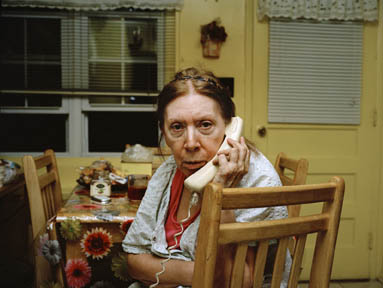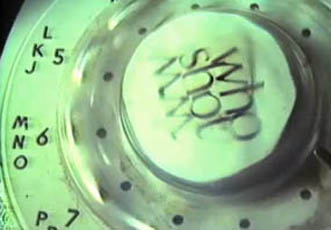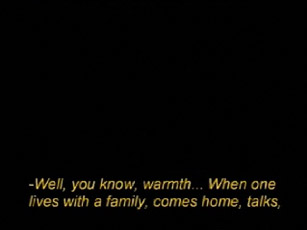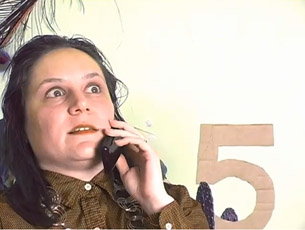presents Where I'm Calling From video by Dale Hoyt, Jan Peacock, Regina Clarkinia, Anna Shteynshleyger; photography by Justine Reyes on view October 29-November 27, 2010; opening reception, November 5, 5-9 |
|||
| "I won't raise my voice. Not even if she starts something. She'll ask me where I'm calling from, and I'll have to tell her. I won't say anything about New Year's resolutions. There’s no way to make a joke out of this." –Raymond Carver, “Where I’m Calling From” Krowswork is pleased to present Where I’m Calling From featuring videos by Dale Hoyt, Jan Peacock, Anna Shteynshleyger, and Regina Clarkinia that explore the telephone for the psychic, elliptical tool that it is, with each artist picking up on the phone’s unsettling, simultaneous relationship to place and placelessness, to home and distance from home. Photographer Justine Reyes makes palpable the honest yearning of place through her revelatory photographs of her mother and uncle in their home and in hotel rooms in various world locales, from the series “Home, Away From Home.” The show will also present an installation of homemade videos by young women recording themselves singing “Telephone” (2010) by Lady Gaga. The disparity between the complex earnestness of these amateur videos, which take place in real homes, as compared to the brash, cinematic, and admittedly addictive video made for the actual version of the song provides interesting commentary on the phone as a touchstone for connection, the definition and flexibility of the video medium, and what constitutes feminism (or not) these days. (See notes below.) |
|
||
In Dale Hoyt’s iconic 1981 video Who Shot MM, a friendly yet almost frantic voice makes repeated calls to operators in various Southern states asking for a number in Houston. A pulsing map of Texas visually reminds the viewer of the recurring rebuffs he receives, with each operator stating the place she is as a way of establishing that it is not the connection in Texas he is seeking. Hoyt chose Texas in part because this was the summer of Who Shot J.R.?, the cliffhanger of the TV show “Dallas” that left America waiting for its conclusion in the next season. Hoyt instead used the stand-in initials of MM—for Marshall McLuhan. |
Jan Peacock’s News from the In-Between (Dream Poems of the Irretrievable Past) is also from 1981 and presents an exploratory narrative of home, and attempts to describe what the distance between two places really represents. Using economical visual storytelling, Peacock uses the telephone as a metaphor for the silent, passive reception of information—a lost time of necessary listening—information that must be processed in order for come to terms with a true sense of being at home with one’s self. |
Notes:
The telephone is a paradox. It provides an instant aural connection that simultaneously denies every other part of your body. Your voice becomes the synecdoche of your entire being. It is an anxiety-making state. This anxiety has up until recently been mitigated by the fact that when you were on the telephone you were at least geographically in one place, as was the person you were talking to. Often you were calling from your home. Now, when we are on the phone with someone, we are often both bodyless and placeless, two moving targets, adding to the uncertainty of this already tenuous connection. The separation of the phone from home signifies an important shift in the fundamental structure our social-psychic fabric. Fast forward to 2010, and the release of the megahit “Telephone” by singer Lady Gaga, who laments the tether of the phone when she sings “Call all you want but there’s no one home and you’re not gonna reach my telephone." Anticipating Gaga, the videos by Shteynshleyger and Clarkinia, made in 2001 and 2009, respectively, pick up on the phone’s new, less transparent role. Its mobility and ubiquity lends itself to greater accountability, thereby requiring new measures of obfuscation. These two artists understand its ability to be manipulated and played with, and to become a tool for individual storytelling and self-definition.
Though only one of Reyes’s photographs in this exhibition features an actual telephone, her body of work is very much responding to Carver’s essential conundrum: how to answer someone about where you are, when really the question is who you are. For Reyes, the answer clearly has to do with her mother and uncle, and by photographing them at home and not at home, she provides a visual control group to discern what about the ephemeral nature of a cherished life can be held on to.
|
|
Anna Shteynshleyger surreptitiously recorded her divorced parents’ conversations over the course of many years. In Conversation she presents a dialogue between them, in which they seem to express their continued affection for one another. Using the ping-pong aspect of telephone conversations to her advantage, emphasizing balance and even-handedness; in this space—a telephone conversation—reality can be synthesized. |
Regina Clarkinia’s Hello, Hunter capitalizes on the theatrical, elliptical potential of hearing and seeing one side of a telephone conversation. The second, silent voice is only known to the woman on the phone. Clarkinia is mixing the phone with video to provide a one-woman video-play that is comic, subtle, and moving. Clarkinia, in some way, provides the answer to the impasse that the other videos suggest; her way is simple and effective: imagination is the key to always being home. |
||
 Late Night Conversation by Justine Reyes
Late Night Conversation by Justine Reyes


